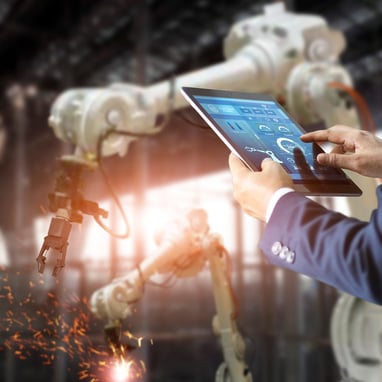It’s human nature for us to be reluctant to any type of change. However, in the world of Manufacturing, it is becoming imperative that we do so. Below are some of the many reasons why companies in the Manufacturing Industry should adopt Digital Transformation tools and resources.
The term IIoT broadly refers to a series of Internet connected sensors and decides that provide real-time data from across the factory floor, allowing for improved visibility for machine performance. With supply chain logistics, it promises to eliminate wasted time and energy associated with inventory oversights. The IoT sensors can be deployed for virtually anything including factory floor machinery, lights, HVAC (Heating, Ventilation, Air Conditioning), and more. Even the global tech firm, CGI, now uses connected sensors in elevators that, in turn, provide real-time data that is used to create predictive maintenance schedules.

- ‘Big Data’ and Analytic Tools
The increased number of connected devices in a manufacturing setting produces massive amounts of data. Tools such as Artificial Intelligence (AI) and machine learning help translate ‘big data’ into actionable insights that are then used to project demand forecasting and predictive maintenance schedules. This serves to discover and eliminate areas of waste and break down data silos, all with the aim to increase efficiency and transparency across the manufacturing process.
- Cloud computing
Cloud computing is widely seen as the ‘backbone’ of these technologies, allowing for over -the-air transfer of real-time data. As opposed to trying to rapidly acquire server storage, cloud computing lets manufacturers to securely retrieve and store the massive amounts of information generated from the factory floor. This creates easy solutions for computationally intensive tasks like risk modelling that informs machine learning; ultimately serving to reduce costs on high powered machinery! Tools using cloud computing also allow for mobility, collecting and analysing data from across the production sites in real time to create an accurate overview of daily performance.
- Advanced Robotics
Many manufacturing companies will have Robotics as a staple in their environments, serving to automate repetitive tasks and heighten the efficiency, while importantly promoting worker safety.
The advancements in robots allow for the automation if increasing sophisticated tasks. Examples include machine arms that can be manipulated by a human operator in a 3D space to simulate specific motions. Those same motions can then become automated while evaluating and optimizing its own performance. Autonomous robot vehicles can create more efficient packing protocols in the warehouse by quickly analysing tasks and choosing the most efficient route to retrieve items, even when accounting for multiple orders.
- Additive manufacturing
The name we might all know as Additive manufacturing is also know as 3D printing, which allows for specialized production of unique or customized products and components. When working with predictive maintenance schedules, additive manufacturing can produce replacement components in one print well before repair or replacement becomes a critical concern. For examples, the popular but mainstream adopters such as Nike connect consumers to the production line by giving them web tools to customize shoe design that that are then 3D printed. These are just a few of the applications, but this technology has implications for the entire production process, allowing for the printing of single items rather than assembly from other components.
Digital thread is a 3D model of physical assets, operational systems, and structures throughout the factory space. Digital thread used with IIoT sensors gives manufacturers a view to the entirety of the whole factory floor in a virtual space, showing asset locations, machine uptime and maintenance needs and even providing a view from the inside of machines. These 3D models are then used to create a digital twin that can promote quick prototyping, train employees prior to introducing them to the physical machines on the floor, and simulate stress testing.
- Augmented Reality (AR)
Using display tools (e.g internet connected glasses or a tablet) can transform the manufacturing experience by providing asset status, performance, or task specific information from a glance. This enhances cyber-physical capabilities by creating a real-time view of any potential maintenance concerns and analytics informed while operators are present on the factory floor. It also serves to train new employees by showing safety protocols for each machine and how that related to their specific duties. AR devices can show precise locations, components, and protocols for maintenance.
As we can see, Digital Transformation tools present a number of opportunities for manufacturers to gain scalable agility, flexibility and operation performance, becoming overall much more lean. It bridges the gap between many isolated processes such as (IT) Information Technology and OT (Operational Technology), creating a manufacturing process that is empowered by cyber-physical capabilities.
***********
To learn more about how Radwell can assist your operation


